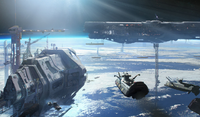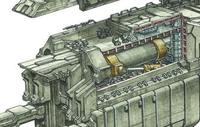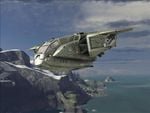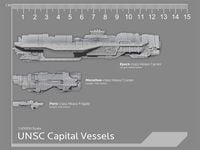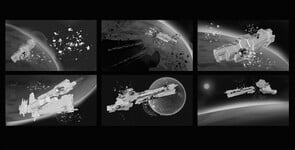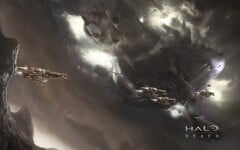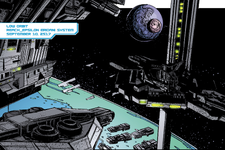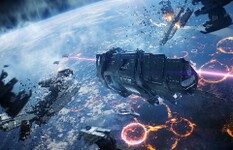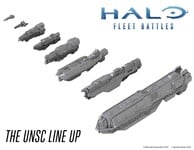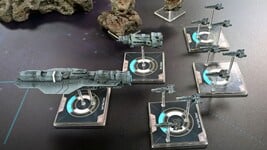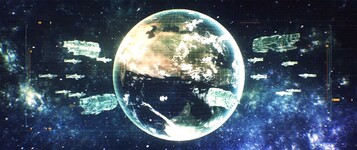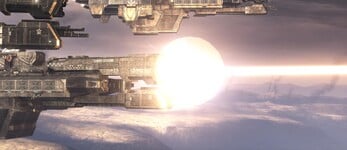User:CMDR RileySV/Sandbox: Difference between revisions
From Halopedia, the Halo wiki
CMDR RileySV (talk | contribs) (Made some changes and added some citations.) |
CMDR RileySV (talk | contribs) (More changes and updates.) |
||
| Line 15: | Line 15: | ||
===Early war=== | ===Early war=== | ||
Impressive fleet actions characterized the early war. | Impressive fleet actions characterized the early war. 40 ships of [[Battle Group X-Ray]] fought a single Covenant vessel over [[Harvest]],<ref>''Halo: Evolutions'', "The Impossible Life and the Possible Death of Preston J. Cole", p. 463-467</ref> over 100 ships saw action in the [[Battle of Alpha Aurigae]]<ref name="hwgenesis">''[[Halo Wars: Genesis]]''</ref><ref>''[[Halo: Evolutions - Essential Tales of the Halo Universe]]'', "[[The Impossible Life and the Possible Death of Preston J. Cole]]", p. 470</ref> and another 70 [[Battle of XI Boötis A|clashed]] with the Covenant at the [[XI Boötis A system]].<ref name="hwgenesis"/> | ||
====Final year of the war==== | ====Final year of the war==== | ||
[[File:HM SigmaOctanus.jpg|thumb|right|The {{UNSCShip|Iroquois}} and a frigate staring down the [[Second Fleet of Solemn Accord]] over [[Sigma Octanus IV]].]] | [[File:HM SigmaOctanus.jpg|thumb|right|The {{UNSCShip|Iroquois}} and a frigate staring down the [[Second Fleet of Solemn Accord]] over [[Sigma Octanus IV]].]] | ||
By the final year of the war, a majority of the UNSC's ground forces had been consolidated at Reach and at Earth. For many colonies, it was only the ships of the navy that were | By the final year of the war, a majority of the UNSC's ground forces had been consolidated at Reach and at Earth. For many colonies, it was only the ships of the navy that were reminders of the UNSC and gave aid to those cut-off. Though in many instances, the Navy couldn't afford the loss of ships and personnel, often leaving these colonies to their own devices including destruction by the Covenant. No appreciable differences could be seen in expeditionary and defensive fleets as the UNSC lost the ability to conduct offensive naval operations. Navy AIs by this point were still assigning ships to squadrons, though at that point they were administrative groupings that had lost meaning over the course of the war. As well, numerous fleets only existed on paper, having been destroyed in lost sectors years prior.<ref name="corerulebook">''[[Halo: Fleet Battles]]'', Core Rulebook - p. 9</ref> | ||
{{Main|Battle of Sigma Octanus IV|Fall of Reach|Battle of Earth}} | {{Main|Battle of Sigma Octanus IV|Fall of Reach|Battle of Earth}} | ||
| Line 49: | Line 49: | ||
UNSC ships were organized into [[fleet]]s; specifically numbered expeditionary fleets and named defensive fleets. Further down, ships were arranged into [[battle group]]s.<ref name="corerulebook"/> As well, [[squadron]]s were a type of tactical grouping for support ships early in the Covenant War,<ref>''Halo: Silent Storm''</ref> but by the end of the war were relegated to a type of administrative grouping.<ref name="corerulebook"/> | UNSC ships were organized into [[fleet]]s; specifically numbered expeditionary fleets and named defensive fleets. Further down, ships were arranged into [[battle group]]s.<ref name="corerulebook"/> As well, [[squadron]]s were a type of tactical grouping for support ships early in the Covenant War,<ref>''Halo: Silent Storm''</ref> but by the end of the war were relegated to a type of administrative grouping.<ref name="corerulebook"/> | ||
Often, naval groupings had a [[flagship]] | Often, naval groupings had a [[flagship]] from which commanding officers lead their groupings from. | ||
===Identification=== | ===Identification=== | ||
There were a few known ways of identifying UNSC ships. There was the [[Hull | There were a few known ways of identifying UNSC ships. There was the [[Hull Code]], which gives each ship a letter classification and a number.<ref>''Halo: Official Spartan Field Manual'', PART 1: INTRODUCTIONS, UNSC ''Infinity'' Layout (p. 14 & 15)</ref><ref>''Halo: Warfleet - An Illustrated Guide to the Spacecraft of Halo'', p. 42 & 43</ref> There was also the [[Ship emblem|ship emblem]], which was a unique image that crew wore on their uniforms.<ref name="cepoa"/><ref name="h2cairo"/> | ||
Some warships also used the [[UNSC REG system]], which was also a special serial number.<ref>''Halo 4'', campaign level, [[Dawn (level)|Dawn]]</ref> There was also the UNc system.<ref name="h2acairo">''[[Halo 2: Anniversary]]'', campaign level [[Cairo Station (level)|Cairo Station]]</ref> | Some warships also used the [[UNSC REG system]], which was also a special serial number.<ref>''Halo 4'', campaign level, [[Dawn (level)|Dawn]]</ref> There was also the UNc system.<ref name="h2acairo">''[[Halo 2: Anniversary]]'', campaign level [[Cairo Station (level)|Cairo Station]]</ref> | ||
| Line 94: | Line 94: | ||
===Armament=== | ===Armament=== | ||
A number of UNSC vessels, particularly those under the control UNSC Navy are equipped with weaponry. | A number of UNSC vessels, particularly those under the control of the UNSC Navy are equipped with weaponry. | ||
====MACs==== | ====MACs==== | ||
{{Main|Magnetic Accelerator Cannon}} | {{Main|Magnetic Accelerator Cannon}} | ||
Revision as of 16:19, October 5, 2019
UNSC starships were Human starships operated by the United Nations Space Command (UNSC).
History
Insurrection
- Main article: Insurrection
The time of the Insurrection saw a number of class additions and developments to the UNSC's fleet. In 2493, the Valiant-class super-heavy cruiser entered service. Though serious cost problems over five years cast doubt in the class' future.[1] At some point in the Insurrection, a new carrier, the Orion-class assault carrier, was built to help with ground operations.[2] One of the last known class additions during the Insurrection was the Halcyon-class light cruiser. In 2510, the class first entered service.[3]
Human-Covenant war
- Main article: Human-Covenant war
CAA and CMA Absorption
In 2525, the UNSC would strip away the CMA's naval resources and give them to NAVCOM.[4] As well, the UNSC would begin to take over the Colonial Administration Authority in the midst of the Human-Covenant war. With these additions, the UNSC received several different types of ships. This included the CAA's Springhill-class mining ship[5][6] and the Diligence-class from the CMA.[7] Both of which would be brought back to service or continued service such as with the UNSC Kronstadt and the CAA Heavy Burden.
Early war
Impressive fleet actions characterized the early war. 40 ships of Battle Group X-Ray fought a single Covenant vessel over Harvest,[8] over 100 ships saw action in the Battle of Alpha Aurigae[9][10] and another 70 clashed with the Covenant at the XI Boötis A system.[9]
Final year of the war
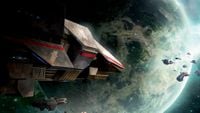
By the final year of the war, a majority of the UNSC's ground forces had been consolidated at Reach and at Earth. For many colonies, it was only the ships of the navy that were reminders of the UNSC and gave aid to those cut-off. Though in many instances, the Navy couldn't afford the loss of ships and personnel, often leaving these colonies to their own devices including destruction by the Covenant. No appreciable differences could be seen in expeditionary and defensive fleets as the UNSC lost the ability to conduct offensive naval operations. Navy AIs by this point were still assigning ships to squadrons, though at that point they were administrative groupings that had lost meaning over the course of the war. As well, numerous fleets only existed on paper, having been destroyed in lost sectors years prior.[11]
- Main articles: Battle of Sigma Octanus IV, Fall of Reach, Battle of Earth
With 152 ships present at the of Battle of Reach,[12] a large number of these ships were destroyed. This included many capital ships such as the UNSC Trafalgar, the flagship of the Epsilon Eridani Fleet and pride of the Navy.[13]
Starting September 5, 2552 all remaining UNSC starships and their fleets were consolidated under a single command grouping under the UNSC Home Fleet.[14] Numerous ships arrived at Earth on October 20, 2552.[15] The ships above Earth would then go onto engage Covenant forces when they arrived the same day.[16] By the end of the war, the plethora of UNSC starships had been reduced to only a few hundred.[17]
Post-war
Following the Human-Covenant war, the surviving UNSC starships were brought back to Sol to be repaired, refitted and counted.[17]
A variety of starship classes and several ship improvements that were created during the war finally became commonplace. The Autumn-class heavy cruiser, the Strident-class heavy frigate and the Infinity-class supercarrier were all added to the fleet. All three have shielding,[18][19] an unprecedented addition to UNSC ships.
As part of ongoing offenses, UNSC Strident-class frigates and Anlace-class frigates were being deployed to the Outer Colonies to route out Covenant remnant occupiers.[20]
Conflict with the Created
- Main article: Created conflict
During the Created's Reclamation, many UNSC starships were disabled by Guardian Custodes.[21] Some ships, were ripped out of Slipstream Space with the activation of the Guardians, like the UNSC Nereid.[22] Shipboard AIs from numerous starships also defected to the Created.[21]
Organization
Management
In the UNSC, ships can also be operated by different departments and branches. Warships like the UNSC In Amber Clad were often operated by the UNSC Navy.[23] UNSC Navy ships were deployed by UNSC Fleet Command.[24] In the case of the UNSC Swift Justice, it was operated by the Incident Response and Investigation division of the UNSC.[25]
Smaller craft were often operated by other branches or were overlapped with another branch. The F-41 Exoatmospheric Multirole Strike Fighter, for example, was most often operated by the UNSC Air Force.[26] The UNSC Department of Commercial Shipping also operated a number of Freighters.
Tactical Groupings
- Main article: UNSC Navy tactical formations
UNSC ships were organized into fleets; specifically numbered expeditionary fleets and named defensive fleets. Further down, ships were arranged into battle groups.[11] As well, squadrons were a type of tactical grouping for support ships early in the Covenant War,[27] but by the end of the war were relegated to a type of administrative grouping.[11]
Often, naval groupings had a flagship from which commanding officers lead their groupings from.
Identification
There were a few known ways of identifying UNSC ships. There was the Hull Code, which gives each ship a letter classification and a number.[28][29] There was also the ship emblem, which was a unique image that crew wore on their uniforms.[30][16]
Some warships also used the UNSC REG system, which was also a special serial number.[31] There was also the UNc system.[32]
The UNSC Department of Commercial Shipping operated its own identification codes for freighters that were primarily used in COM transmissions.[33]
Personnel
It is expected of all navy ship personnel to participate in working parties. The working parties help with routine maintenance and replenishment.[34]
Leadership
The leader of a UNSC starship, like other human starships, is referred to as a Captain regardless of actual rank.[35] The actual military rank of the leader is dependent on the size of the ship. Those of the rank Lieutenant often are in charge of small support vessels, Commanders are in charge of small warships, and Captains are in charge of line warships.[36]
UNSC Starships were often given a Ship Director, an AI who could manage much of the ship's tasks with the Captain's authority. Generally, these AI were "Smart".[37]
Traditions and culture
Navy personnel UNSC ships often follow old naval tradition. Boarding a UNSC warship is considered a ceremony, not a formality. When boarding a ship, the boarder requests permission from the officer on deck. The officer on deck will reply with a curt "Very well".[34]
"Dead fleets" or "paper fleets" are maintained as tradition and to honor those who died while serving. Inadvertently, some starships will be attached to these fleets by bureaucratic error. Many crewmen regarded this as a bad omen.[11]
Design
A number of corporations helped construct UNSC ships including Sinoviet Heavy Machinery, Aerofabrique SA, TanSec AB, and Reyes-McLees Shipyards. Reach, Tribute, and Mars had ship building yards.
Facilities
Design guidelines for ships emphasize that the command crew should have visibility of the surrounding exterior area of the ship. This is usually achieved through windows on the bridge.[39]
UNSC ships have an internal deck naming structure. On most ships, the Hangar deck is considered Zero Deck. Decks below that are "belowdeck" and are numbered in descending order starting at First Deck. Everything above the hangar deck is a "level", starting at Level One and going in an ascending order.[40]
Facilities to create simulated War Games training sessions could be found on several ships. Though they were mostly on post-war vessels and most prominently on the UNSC Infinity.[41]
From the Phoenix-class carrier UNSC Spirit of Fire[42][43] to the Marathon-class heavy cruiser UNSC Say My Name,[44] numerous ships featured holotables for battlefield situational displays.
Cryo chambers were an important feature that allowed the crews to travel large distances without aging as much. Cryo facilities were often large and individual chambers displayed crew member names.[45]
UNSC starships also featured mess halls,[30][46] hangar bays,[30][47] and armories.[48][49]
Crew quarters on UNSC navy ships vary by ship type. Halberd-class destroyers crew quarters were cramped[50] with members being allocated a single sleeping pod that would sometimes need to be shared when the ship has additional crew.[39]
Engines
- Main articles: Fusion drive, Shaw-Fujikawa Translight Engine
UNSC ships were equipped with fusion drive engines to help them move and maneuver in real-space. Shaw-Fujikawa drives help ships reach supraluminal speeds.
Armament
A number of UNSC vessels, particularly those under the control of the UNSC Navy are equipped with weaponry.
MACs
- Main article: Magnetic Accelerator Cannon
MACs are massive coil guns that are used to accelerate multi-ton projectiles at extremely high velocities. These projectiles are composed of Titanium-A, depleted Uranium, and/or Tungsten with a ferrous (iron) core.[51]
As an example, frigate based MACs are capable of firing 600-ton slugs at roughly 30/kms.[52] UNSC Infinity has miniature MAC guns along its hull, to compliment its built in, larger MAC guns.[53]
Missile batteries
UNSC ships generally carry an array of missile batteries. Most UNSC ships carry Archer Missiles in one of many pods. These include the M58 Archer Missile Delivery System and the M42 Archer Missile Delivery System. These were complemented with Fusion rockets.
Point defense batteries
- Main article: Point-defense gun
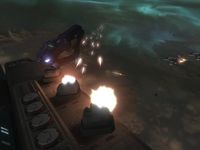
Point defense batteries were common on UNSC warships. Some of these batteries include the M910 Rampart, the M870 Rampart, the M710 Bulwark, and the Mark 57 Arena.
Nuclear weapons
- Main article: Nuclear weapon
UNSC warships usually contain nuclear weapons of some sort. Generally they were the Shiva-class nuclear missile.[54]
Docking capabilities
UNSC ships had docking capabilities, though the exact details are dependent on what the ship is docking with. Stalwart-class light frigates were capable of docking with Moncton-class orbital weapon platforms.[16] Class-L flash-docks routinely held frigates and corvettes, though the UNSC Pillar of Autumn was able to use one.[55]
Types
Starfighter
- Main article: Space fighter
The UNSC operates several types of starfighters. The most common being the GA-TL1 Longsword-class Interceptor. The YSS-1000 Sabre was a secretive starfighter that was mostly used in the Inner colonies. The F-41 Broadsword XMSF was a mainline starfighter that lacked the technology of the Sabre. The S-14 Baselard and Nandao fighter were other types of UNSC starfighter.
Dropship
- Main article: Dropship
The most common dropships in the UNSC were the Pelicans. Numerous types existed accross numerous years, filling roughly same the role. Heavier dropships were also employed such as various Condor variants, the D82-EST Darter, and the D96-TCE Albatross. The largest of type of dropship used was the D20 Heron. The UNSC also had dropship escape pods, the Class-3 Bumblebee.
Colony ship
- Main article: Colony ship
The UNSC also operated a colony ship class, the Phoenix-class colony ship.
Support starships
- Main article: Support starship
Several types of support ships that were used include the stealthy Prowler and its subtypes. Other stealth ship classes existed including the Chiroptera-class stealth vessel. There was also the incredibly small sloop. Another type of ship that was used by the UNSC was the Calypso-class exfiltration craft. Following the UNSC's take over of the CAA, the Springhill-class mining ship helped build materiel for UNSC forces.
Warships
- Main article: Warship
The UNSC employs a number of warships including frigates, destroyers and cruisers. The Vindication-class was unique as it was a Battleship, an uncommon warship in UNSC ship design and classification. UNSC carriers were among the largest, most heavily armed ships the UNSC possesed. Two carrier classes were so large that frigates could dock with them; the Punic-class supercarrier and the Infinity-class supercarrier.[56]
Other
ONI's Reverse Engineering and Prototyping–Xenotechnology department have recovered, refit and begun testing on multiple Covenant starships.[57]
List of UNSC starships
The following is a list of the starships that belong to and are used by the United Nations Space Command.
Carriers
| Class | Ship Name | Notes |
|---|---|---|
| Epoch-class heavy carrier | UNSC Epoch | |
| UNSC Atlas | ||
| Infinity-class supercarrier | UNSC Eternity | Not Completed |
| UNSC Infinity | ||
| Orion-class assault carrier | UNSC Fifth Winter | |
| UNSC Orion | ||
| Phoenix-class carrier | UNSC Spirit of Fire | Active but officially listed as lost with all hands. |
| Poseidon-class light carrier | UNSC Milwaukee | |
| UNSC Poseidon | ||
| Punic-class supercarrier | UNSC Punic | |
| UNSC Trafalgar | Flagship of the Epsilon Eridani Fleet. Destroyed over Reach | |
| Unknown | UNSC All Under Heaven | |
| UNSC Magellan | ||
| UNSC Musashi | ||
| UNSC Stalingrad | ||
| UNSC Totem Lake | ||
| UNSC Witness |
Cruisers
Destroyers
Frigates
| Class | Ship Name | Notes |
|---|---|---|
| Anlace-class frigate | UNSC Anlace | |
| Charon-class light frigate | UNSC Aegis Fate | |
| UNSC Bellerophon | Captured by Insurrectionists, renamed Bellicose. | |
| UNSC Charon | ||
| UNSC Chioglossa | ||
| UNSC Forward Unto Dawn | Severed in half by Forerunner Portal | |
| Unidentified UNSC frigate | ||
| Paris-class heavy frigate | UNSC Commonwealth | Decommissioned, in process of being scrapped during Fall of Reach. |
| UNSC Cascadia | ||
| UNSC Gettysburg | ||
| UNSC Grafton | ||
| UNSC Paris | ||
| UNSC Promise of Dawn | ||
| UNSC Saratoga | ||
| UNSC Savannah | ||
| Strident-class heavy frigate | UNSC Strident | |
| Stalwart-class light frigate | UNSC In Amber Clad | Infected by Flood, used to infect High Charity |
| UNSC Meriwether Lewis | ||
| UNSC Midsummer Night | ||
| UNSC Stalwart Dawn | ||
| Unknown | AC-54 | |
| UNSC Allegiance | ||
| UNSC Buenos Aires | ||
| UNSC Burlington | ||
| UNSC Euphrates | ||
| UNSC Fair Weather | ||
| FFG-045 | ||
| UNSC Plateau | ||
| UNSC Providence | ||
| UNSC Purpose | ||
| UNSC Ready or Not | ||
| UNSC Redoubtable | ||
| UNSC Swift Justice | ||
| UNSC Tannenberg | ||
| UNSC Tripping Light |
Prowlers
Corvettes
| Class | Ship Name | Notes |
|---|---|---|
| Gladius-class corvette | UNSC Gladius | |
| UNSC Sagan Blue | ||
| Fast-attack Corvette | UNSC Two for Flinching | |
| Unknown | UNSC Bum Rush | |
| UNSC Callisto | ||
| UNSC Chalons | ||
| UNSC Coral Sea | ||
| UNSC Pony Express | ||
| UNSC Glamorgan |
Colony Ships
| Class | Ship Name | Notes |
|---|---|---|
| Phoenix-class colony ship | UNSC Phoenix | |
| UNSC Skidbladnir | Scrapped in colonization of Harvest |
Cargo and Transportation Ships
| Class | Ship Name | Notes |
|---|---|---|
| Ammunition Ship | UNSC Diadochi | Crashed on what became Partition |
| UNSC Taulanti | ||
| Cargo ship | UNSC Dartmouth | |
| Cargo Freighter | UNSC Onan | |
| Mona Lisa | Converted to a prison transport, Destroyed | |
| Diplomatic Shuttle | Han | |
| UNSC passenger schooner | UNSC Donoma | |
| UNSC Santori | ||
| Unknown | UNSC Jamaica | |
| UNSC Nereid |
Other Ships
Apocrypha
Ships
A few UNSC craft have appeared in officially created, but non-canon materials. The UNSC Andraste was a ship that appeared in a piece of concept art for Halo 3.[58] The UNSC Frontend, an M-class carrier was the center piece of a cancelled idea for Halo Wars 3.
Depictions
In the introductory level Prepare To Drop in Halo 3: ODST, the UNSC In Amber Clad was represented with a model of a Charon-class light frigate. In all other media, including Halo 2: Anniversary, the In Amber Clad is a Stalwart-class light frigate.
In Halo 4, the Charon-class UNSC Forward Unto Dawn is depicted as a modified Strident-class. This depiction is non-canon.[59] The Strident-class itself is also depicted differently between the campaign mission Midnight and Spartan Ops/Daybreak.
Gallery
Concept art
- HW2C-Space.jpg
Concept art of a space combat mode for a Halo Wars 3, featuring several UNSC starships.
Concept art of various destroyed UNSC ships for Halo: Fleet Battles.
Concept art of UNSC frigates underneath a CSO-class supercarrier.
Overview
- HM-Infinity.png
Several types of UNSC starships in orbit.
The UNSC starship line-up for Halo: Fleet Battles.
Several UNSC starships in orbit over Camber.
Numerous UNSC ships fighting Covenant over Sigma Octanus IV.
Several Charon-class light frigates at the Battle of Voi.
Sources
- ^ Halo Waypoint: Canon Fodder - Bulkhead Banter
- ^ Halo Waypoint: Canon Fodder - Armory Amore
- ^ Halo: Combat Evolved: Sybex Official Strategies & Secrets, p. 60
- ^ Halo Wars, collectible, Halo Wars Timeline Events
- ^ Halo 4: The Essential Visual Guide, Locations, p. 208
- ^ Halo 4, multiplayer map, Adrift
- ^ Halo Waypoint: Canon Fodder - Clarity & Grace
- ^ Halo: Evolutions, "The Impossible Life and the Possible Death of Preston J. Cole", p. 463-467
- ^ a b Halo Wars: Genesis
- ^ Halo: Evolutions - Essential Tales of the Halo Universe, "The Impossible Life and the Possible Death of Preston J. Cole", p. 470
- ^ a b c d Halo: Fleet Battles, Core Rulebook - p. 9
- ^ Halo: The Fall of Reach, p. 295-297
- ^ Halo: First Strike, p. 168
- ^ Halo Legendary Crate, Naval Records Archives
- ^ Halo 2, campaign level, The Armory
- ^ a b c Halo 2, campaign level, Cairo Station
- ^ a b Halo Mythos: A Guide to the Story of Halo, p. 132
- ^ Spartan Ops, Episode 1: Departure
- ^ Halo Waypoint: Canon Fodder - En Voyage
- ^ Halo: Warfleet – An Illustrated Guide to the Spacecraft of Halo, p. 38 & 39
- ^ a b Halo 5: Guardians, campaign level, Guardians
- ^ Halo: Tales from Slipspace, Undefeated
- ^ Halo: Warfleet – An Illustrated Guide to the Spacecraft of Halo, p. 36 & 37
- ^ Halo Encyclopedia, p. 64 (2011)
- ^ Halo: Retribution, Chapter 2
- ^ Halo 4: The Essential Visual Guide, Vehicles, p. 114
- ^ Halo: Silent Storm
- ^ Halo: Official Spartan Field Manual, PART 1: INTRODUCTIONS, UNSC Infinity Layout (p. 14 & 15)
- ^ Halo: Warfleet - An Illustrated Guide to the Spacecraft of Halo, p. 42 & 43
- ^ a b c Halo: Combat Evolved, campaign level, The Pillar of Autumn
- ^ Halo 4, campaign level, Dawn
- ^ Halo 2: Anniversary, campaign level Cairo Station
- ^ Halo: Contact Harvest, p. 34
- ^ a b Halo: Official Spartan Field Manual, PART 1: INTRODUCTIONS, Welcome Aboard the UNSC Infinity! (p. 10)
- ^ Halo: Warfleet – An Illustrated Guide to the Spacecraft of Halo, p. 90-92
- ^ Halo: Official Spartan Field Manual, PART 8: UNSC ORGANISATION, NAVCOM Ranks (p. 140-141)
- ^ Halo: Warfleet – An Illustrated Guide to the Spacecraft of Halo, p. 90-92
- ^ Halo Waypoint: Community Update - Chasing Shadows
- ^ a b Halo: Warfleet – An Illustrated Guide to the Spacecraft of Halo, p. 32-33
- ^ Halo: Silent Storm, Chapter 4
- ^ Halo Waypoint: Canon Fodder - Needle Me This
- ^ Halo Wars, campaign level, Dome of Light
- ^ Halo Wars 2, campaign level A New Enemy
- ^ Halo 3: ODST, campaign level, Prepare To Drop
- ^ Halo Wars, campaign level, Escape
- ^ Halo Legends, Babysitter
- ^ Halo 5: Guardians, campaign level, Blue Team
- ^ Halo: Combat Evolved, campaign level, The Maw
- ^ Halo: Evolutions, "Midnight in the Heart of Midlothian", p. 86
- ^ Halo Mythos, p. 82-83
- ^ Halo: The Fall of Reach, p. 283
- ^ Halo: The Fall of Reach, p. 108 (2001 edition); p. 130 (2010 edition)
- ^ Halo 4, campaign level, Infinity
- ^ Halo: The Fall of Reach, p. 147
- ^ Halo: Reach, campaign level, The Pillar of Autumn
- ^ Halo Waypoint: Canon Fodder - Infinity & Beyond
- ^ Halo Waypoint: Catalog Interaction - Page 23
- ^ The Art of Halo 3
- ^ Halo Waypoint: Canon Fodder - Have S'moa
| ||||||||||||||||||||||||||||||||||||||||||||||||||||||||


